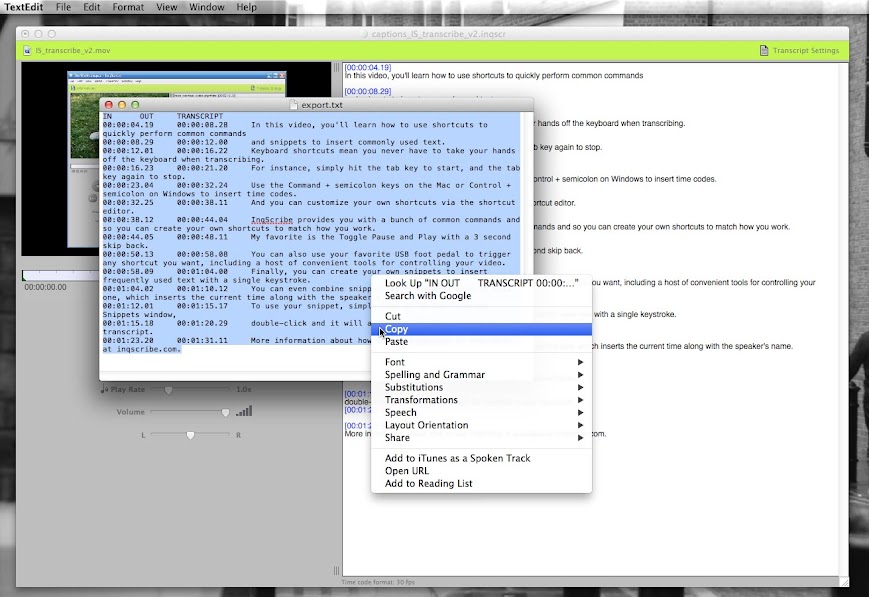
They may go by different names (voice-to-text apps, audio-to-text apps, transcription apps, speech-to-text apps, etc.) but they fall in one of these categories. There are 3 types of audio-to-text converters:ģ. This may work for some people who need transcripts for internal use, but if you want to print or share the transcripts with others, then you’ll need to reserve time for proofreading. The accuracy is significantly lower for multi-speaker recordings. The downside is that the accuracy of transcripts produced by these applications is inconsistent (ranging between 40-95%).
#INQSCRIBE VIDEO TO TEXT MANUAL#
The upside of using audio-to-text converters is that they can obviously save you a ton of time and energy by automating what is otherwise a very tedious and manual process. Today, practically every dictation and transcription app worth talking about uses speaker dependent speech recognition technology in combination with AI/Machine Learning. You have probably used this version in some of your favorite apps like Apple’s Siri, Google Assistant, Amazon’s Alexa, and Shazam. The Speaker Dependent version is capable of holding a larger vocabulary, but needs to be trained to recognize individual speakers’ voices.

This version is often used in phone IVRs where limited vocabulary is required within a known context. The Speaker Independent version can understand a limited set of words, irrespective of who is speaking. Speech recognition can be divided into two categories – Speaker Dependent and Speaker Independent. Now speech recognition is a vast topic, but here’s a simple explanation for the purposes of this post: This technology uses a complex combination of linguistics, mathematics, and computing to understand human speech and convert it into text or commands.
#INQSCRIBE VIDEO TO TEXT HOW TO#
This post explains what audio-to-text converters can and cannot do, and how to go about selecting the right one for YOU.įirst up, here’s a roundup of the best free and paid audio-to-text converters available out there: List of Free and Paid Audio-to-Text Converters AppĪudio-to-text converters work on speech recognition technology. But each solution differs in capability and functionality. In MAXQDA go to Documents->Import f4/f5 transcript, select your newly edited text file. It will then prompt you to select the accompanying video, do so, and as long as your video is in the right format, you’re ready to rock.In essence they all do the same thing – convert audio to text. So now your file looks like this and is ready to be imported into MAXQDA: Note that it won’t fix the first instance of a timestamp, in my example it won’t catch the first line. Then I modify the replace box by placing a # symbol in front of the zero like this and replace all: I copy and paste that selection into the find box and the replace box. I first select the leading zero and the previous space like so: Next all we need to do is add the leading # symbol to every line. Now you should have a file that looks like this:

Note that there is a space after the # symbol. It should highlight all of the tabs now like this: Now I’m going to go to Edit->Find->Find and Replace… Now select the tab space between the timestamp and the text, copy it, and paste that space into the Find box. Open your exported text file in TextEdit or any other word processor with the ability to Find & Replace. For my sample transcript the file looks like this: First in InqScribe select File->Export->Tab-delimited Text… Uncheck Export Out Points and Export Speaker Names Luckily it’s pretty easy to do a quick conversion. The timestamps come after the text, and follow the format #HH:MM:SS-m# In InqScribe the same sample transcript for me would look like this: Interviewer: Hi how are you doing? #00:00:05-0# MAXQDA only recognizes transcripts that follow the f4/f5 () format & there is no way to link video to imported transcript after you’ve imported the transcript. Once imported, I want to be able to edit it within MAXQDA.

Goal: Be able to import my already completed InqScribe video transcript and have it linked with the video file within MAXQDA.
#INQSCRIBE VIDEO TO TEXT MAC#
ATLAS.ti & NVivo both have rich features in their Windows versions, but their Mac versions still lag behind in features, especially with transcription.

I chose MAXQDA 12 since it has the most rich transcription feature set for Macs. I have a lot of transcripts I’ve done in InqScribe, and recently I’ve wanted to dive into Computer Assisted Qualitative Data AnalysiS (CAQDAS).


 0 kommentar(er)
0 kommentar(er)
